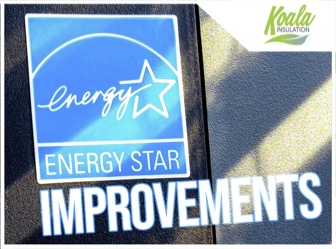6 ENERGY STAR Changes to Reduce Southeastern Texas Bills

Every year, homeowners try to find new ways to reduce energy waste and save on electricity. The issue in many cases is that safety or comfort is impacted. This is especially a significant risk during extreme temperatures in the summer or winter.
As an ENERGY STAR® Partner, Koala Insulation of Pearland and other local companies work together to reduce our community's carbon footprint while also taking a chunk out of energy bills. We help by tackling the problems caused by the appliances and materials that are contributing to energy waste, higher utilities, and discomfort in your home.
- Heating & Cooling System
Energy-efficient heat pumps are not only more environmentally friendly than furnaces or boilers, but they're also more effective at improving your environment. Newer units are a big contributor to cutting costs but they're also a great return on investment opportunity.
The furnace or boiler of your heating and cooling system is responsible for about a third of the energy used annually in your home. Usage obviously increases when you're trying to reduce the impact of drastic temperatures throughout the year. Heat pumps are useful year-round, reducing the strain on your other heating and cooling appliances without sacrificing comfort and safety.
- Water Heater
The second-highest energy user in a house is typically the water heater. Tankless or solar-powered water heaters are upgrades that reduce energy waste because they're designed to run more efficiently and use more energy-efficient resources.
An energy-efficient model that falls under the ENERGY STAR recommendations can help save your household about $300 on energy bills each year. For example, a tankless water heater can save up to 34% more energy by providing on-demand heat, rather than storing gallons of unused heated water like other traditional water heaters. These kinds of energy-conserving changes don't impact the abilities of your systems and instead, provide a better experience for your environment.
- Upgraded Insulation
According to the Department of Energy, updated insulation in U.S. homes reduces heating and cooling costs by 15% on a national average. Material installed from your attic to the basement includes between ceiling joists, under floorboards, and within external and internal walls. Your home's insulation reduces heat loss by slowing heat transfer, improving temperature regulation, and supporting the climate control capabilities of other systems.
While a building has quality insulation installed during construction, the material wears down over time. Many types of insulation can last up to 15 years but problems like moisture, pests, and disturbances can rapidly increase the rate of deterioration. Evaluations need to be regularly scheduled to check for hidden damages and poor coverage to reduce the effects of deteriorated material.
- Air Sealing
Air leaks are gaps, cracks, and openings in your house that can account for up to 40% of wasted energy from heating and cooling. Unfortunately, many homeowners forgo regular air sealing inspections because of the “breathable home” myth. Put simply, they worry that sealing the building can create a ‘stuffy environment.’
Sealing, however, won't negatively impact your ventilation system, which is truly responsible for reducing uncomfortable stuffiness. Instead, air sealing helps to regulate airflow by blocking spaces where heat and conditioned air can escape. Around windows, doors, and other exterior connection points are the most common money-draining culprits. However, there are a number of other hidden spaces that need to be inspected by professionals to reduce the risk of poor indoor air quality, pest infestations, moisture, and humidity.
- High-Performing Windows or Storm Windows
A helpful step to reducing energy waste is to air seal around window panes and edges. However, upgrading the actual window can help to cut back on heating and cooling costs even further. Older windows are often drafty, but the glass is what contributes to greater problems: heat and UV exposure. High-performance and storm windows can lower a household's energy bills by an average of 12%; this average increases for windows on the sides of the house that directly face the sun.
Windows with Low-E glass coating, or low-emissivity, reduce heat in your home that contributes to irregular fluctuation in temperature throughout the day. This coating also has a number of benefits that impact other areas in your home. Low-e-coated glass reduces the sun's impact on floors, carpets, and furniture, preventing discoloration and damage from overexposure.
- Smart Thermostat
We mentioned earlier that your furnace or boiler is typically responsible for a third of your heating and cooling energy costs. Did you know that the entirety of the heating and cooling system is responsible for about half of the energy bill of U.S. households?
This significant amount is caused by ineffective temperature regulation resulting in higher HVAC usage. While it’s largely in part because of improperly installed insulation and air sealing, it’s also often because of poor thermostat decisions. One way to tackle this problem is by installing a smart thermostat.
Smart thermostats schedule appropriate changes while monitoring energy usage throughout the year. Many homeowners make mistakes like shifting the temperature too often during the day, leaving the heating or AC on while they’re out, or forgetting to adjust the input once the house is comfortable. Smart thermostats improve your energy efficiency by finding the best way to minimize energy usage while maintaining a comfortable environment.
Learn More About Energy Star Savings With A Certified Professional
Finding new ways to reduce your energy bill shouldn’t include sacrificing your comfort and safety. Although you don’t need to start replacing every appliance in your house, consider these suggestions to make smarter upgrades while you start making changes. Regular maintenance and evaluations will also go a long way to contribute to a significantly reduced bill every month. For more information on how to keep cutting back on energy waste, contact your local experts at Koala Insulation of Pearland today to schedule your free evaluation.
Find Your Location


Get a quote


